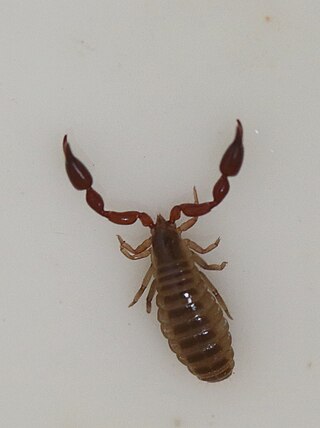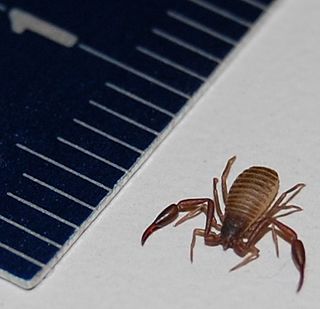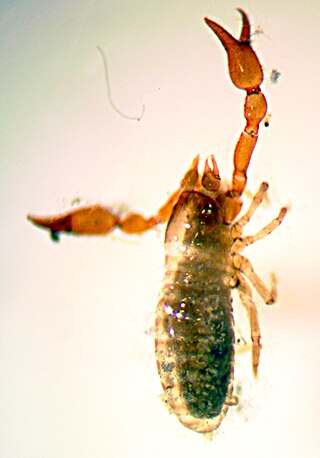| Anatemnus | |
|---|---|
 | |
| Anatemnus chaozhouensis | |
| Scientific classification | |
| Kingdom: | |
| Phylum: | |
| Class: | |
| Order: | |
| Superfamily: | |
| Family: | |
| Genus: | Anatemnus Beier, 1932 |
| Species | |
See text | |
Anatemnus is a genus of pseudoscorpions in the Atemnidae family.
| Anatemnus | |
|---|---|
 | |
| Anatemnus chaozhouensis | |
| Scientific classification | |
| Kingdom: | |
| Phylum: | |
| Class: | |
| Order: | |
| Superfamily: | |
| Family: | |
| Genus: | Anatemnus Beier, 1932 |
| Species | |
See text | |
Anatemnus is a genus of pseudoscorpions in the Atemnidae family.
The genus contains the following species:

Pseudoscorpions, also known as false scorpions or book scorpions, are small, scorpion-like arachnids belonging to the order Pseudoscorpiones, also known as Pseudoscorpionida or Chelonethida.

The spider genus Steatoda, in the family Theridiidae, includes about 120 recognized species, distributed around the world. One common name is cupboard spider, for many species build their webs in dark, sheltered, undisturbed places around the house or garden, in sheds and garages, under garden, compost bins, and the like. Signs of the cupboard spider include small white spots of spider droppings, like small splashes of paint, on the floor underneath the web.

Xysticus is a genus of ground crab spiders described by C. L. Koch in 1835, belonging to the order Araneae, family Thomisidae. The genus name is derived from the Ancient Greek root xyst, meaning "scraped, scraper".

Cheiracanthium, commonly called yellow sac spiders, is a genus of araneomorph spiders in the family Cheiracanthiidae, and was first described by Carl Ludwig Koch in 1839. They are usually pale in colour, and have an abdomen that can range from yellow to beige. Both sexes range in size from 5 to 10 millimetres. They are unique among common house spiders because their tarsi do not point either outward, like members of Tegenaria, or inward, like members of Araneus), making them easier to identify. The name is a reference to the backwardly directed process on the cymbium of the male palp. The species epithet is derived from the Greek Ancient Greek: χείρ, romanized: cheir, meaning "hand", and Acanthium, a genus of thorny-stemmed plants.
Feaella is a genus of pseudoscorpions in the family Feaellidae, first described by Edvard Ellingsen in 1906.

Lechytia is a genus of pseudoscorpions in the subfamily Lechytiinae within the family Chthoniidae. It is the sole genus in its subfamily and contains 22 described species from many parts of the world.

Oratemnus is a genus of pseudoscorpions in the family Atemnidae.
Psechrus is a genus of cribellate araneomorph spiders in the family Psechridae, and was first described by Tamerlan Thorell in 1878.

Dipoena is a genus of tangle-web spiders that was first described by Tamerlan Thorell in 1869.

Hans Henderickx (1961–2016) was a Belgian entomologist specializing in Invertebrates born in Mol, Belgium.

Cheliferidae is a family of pseudoscorpions in the order Pseudoscorpiones, first described by Antoine Risso in 1827.

Microbisium is a genus of pseudoscorpions in the family Neobisiidae. There are about 12 described species in Microbisium.

Withiidae is a family of pseudoscorpions, first described by Joseph Conrad Chamberlin in 1931.
Lagynochthonius is a genus of pseudoscorpions in the family Chthoniidae. It was described in 1951 by Austrian arachnologist Max Beier.

Tyrannochthonius is a genus of pseudoscorpions in the family Chthoniidae. It was described in 1929 by American arachnologist Joseph Conrad Chamberlin.
Dactylochelifer is a genus of pseudoscorpions in the family Cheliferidae, first described by Max Beier in 1932.

Geogarypus is a genus of pseudoscorpions in the Geogarypidae family. It was described in 1930 by American arachnologist Joseph Conrad Chamberlin. The genus has a cosmopolitan distribution.
Anatemnus subvastus is a species of pseudoscorpion in the Atemnidae family. It is endemic to Australia. It was described in 2014 by Australian arachnologists Jason Alexander, Mieke Burger and Mark Harvey. The specific epithet subvastus, from Latin: sub ('under') and vastus, refers to the species’ underground habitat in the semi-arid Pilbara.